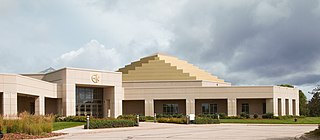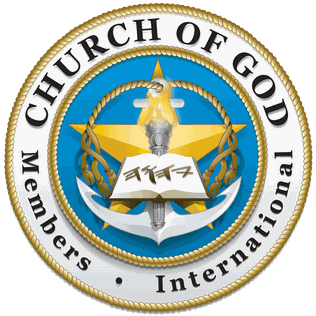
The Philippine Independent Church is an independent Christian denomination, in the form of a nationalist church, in the Philippines. Its schism from the Roman Catholic Church was proclaimed during the American colonial period in 1902, following the end of the Philippine–American War, by members of the Unión Obrera Democrática Filipina due to the mistreatment towards the Filipinos by Spanish priests, and influenced by the executions of José Rizal and Filipino priests and prominent secularization movement figures Mariano Gomez, José Burgos, and Jacinto Zamora, during earlier Spanish colonial rule.

Iglesia ni Cristo is an independent Nontrinitarian Christian church, founded in 1913 and registered by Felix Y. Manalo in 1914 as a unipersonal religious corporation to the Insular Government of the Philippines.

Eckankar is a new religious movement founded by Paul Twitchell in 1965. The spiritual home is the Temple of ECK in Chanhassen, Minnesota. Eckankar is not affiliated with any other religious group.

In the indigenous religion of the ancient Tagalogs, Bathala/Maykapal was the transcendent Supreme Being, the originator and ruler of the universe. He is commonly known and referred to in the modern era as Bathala, a term or title which, in earlier times, also applied to lesser beings such as personal tutelary spirits, omen birds, comets, and other heavenly bodies which the early Tagalog people believed predicted events. It was after the arrival of the Spanish missionaries in the Philippines in the 16th century that Bathala /Maykapal came to be identified with the Christian God, hence its synonymy with Diyos. Over the course of the 19th century, the term Bathala was totally replaced by Panginoon (Lord) and Diyos (God). It was no longer used until it was popularized again by Filipinos who learned from chronicles that the Tagalogs' indigenous God was called Bathala.

Christianity is the predominant religion in the Philippines, with Roman Catholicism being its largest denomination. Sizeable Muslim and non-religious minorities are also present.

The Members Church of God International, abbreviated as MCGI, is an international Christian religious organization with headquarters in the Philippines. It is popularly known in the Philippines as Ang Dating Daan, the title of its flagship radio and television program and the longest-running religious program in the Philippines which was hosted by Eli Soriano, MCGI's "Overall Servant" until his death in 2021.

Cardona, officially the Municipality of Cardona, is a 3rd class municipality in the province of Rizal, Philippines. According to the 2020 census, it has a population of 50,143 people.

Felix Ysagun Manalo , also known as Ka Felix, was the leader and the first Executive Minister of Iglesia ni Cristo. Followers see Manalo as the Messenger of God in these last days. He is the father of Eraño G. Manalo, who succeeded him as Executive Minister of the INC, and the grandfather of Eduardo V. Manalo, the current Executive Minister of Iglesia ni Cristo.

Protestant denominations arrived in the Philippines in 1898, after the United States took control of the Philippines from Spain, first with United States Army chaplains and then within months civilian missionaries.
Spiritual Christianity is the group of belief systems held by so-called folk Protestants, including non-Eastern Orthodox indigenous faith tribes and new religious movements that emerged in the Russian Empire. Their origins are varied: some come from Protestant movements imported from Europe to Russia by missionaries, travelers and workers; others from disgust of the behavior of Orthodox priests, still others from the Bezpopovtsy Raskolniks. Those influences have mixed with folk traditions resulted in communities that are collectively called sektanty (sectarians). Such communities were typically documented by Russian Orthodox clergy with a label that described their heresy such as not fasting, meeting on Saturday (sabbatarians), rejecting the spirit, body mutilation (castigators), self-flagellation, or suicide.
The Patriotic Oath is one of two national pledges of the Philippines, the other being the Pledge of Allegiance to the Flag. It is commonly recited at flag ceremonies of schools—especially public schools—immediately after singing the Philippine national anthem but before reciting the Pledge of Allegiance to the Flag.

The Propaganda Movement encompassed the activities of a group of Filipinos who called for political reforms in their land in the late 19th century, and produced books, leaflets, and newspaper articles to educate others about their goals and issues they were trying to solve. They were active approximately from 1880 to 1898, and especially between 1880 and 1895, before the Philippine Revolution began.

José Protasio Rizal Mercado y Alonso Realonda was a Filipino nationalist, writer and polymath active at the end of the Spanish colonial period of the Philippines. He is considered the national hero of the Philippines. An ophthalmologist by profession, Rizal became a writer and a key member of the Filipino Propaganda Movement, which advocated political reforms for the colony under Spain.

Historical markers are installed by the National Historical Commission of the Philippines (NHCP) in the Philippines and places abroad that signify important events, persons, structures, and institutions in Philippine national and local histories. The plaques themselves are permanent signs installed by the NHCP in publicly visible locations on buildings, monuments, or in special locations. Local municipalities and cities can also install markers of figures and events of local significance. Though they may have the permission of the NHCP, these markers are barred from using the seal of the Republic of the Philippines.
Rizalista is a collective term which refers to a cult whose members associate themselves with José Rizal, an important figure of the Philippine Revolution. About 200 Rizalista groups exist in the Philippines, many of which are based in Rizal's hometown of Calamba, Laguna. Some of these groups are non-governmental organizations which aims to live Rizal's ideals through civic programs while some are spiritual in nature giving spiritual or religious importance to Rizal.
The Iglesia Watawat Ng Lahi, Inc. is a socio-folk religious group based on Lecheria Hill in Calamba, Laguna, Philippines which believes in the divinity of José Rizal, a historic figure of the Philippine Revolution. It is often considered as the original Rizalist group among the many other Rizalista religious movements.

San Juan de Dios Parish Church, also San Rafael Church, is an 18th-century Roman Catholic church situated in Brgy. Poblacion, in San Rafael, Bulacan, Philippines. Its titular patron is St. John of God; Saint Raphael, archangel, is the secondary patron saint. It is in this church that the Battle of San Rafael took place, wherein hundreds of retreating Filipino soldiers and civilians lost their lives during a battle with the Spanish on November 30, 1896. A historical marker by the National Historical Commission of the Philippines was installed in front of the church in 1997 to commemorate the massacre of an estimated 800 Filipinos.

Malays played a significant role in pre-Hispanic Philippine history. Malay involvement in Philippine history goes back to the Classical Era with the establishment of Rajahnates as well as the Islamic era, in which various sultanates and Islamic states were formed in Mindanao, the Sulu Archipelago, and around Manila.

Kabataan, also known as the Kabataan Partylist and formerly known as Ang Nagkakaisang Kabataan Para sa Sambayanan, is a partylist in the Philippines affiliated with the leftist political coalition Makabayan. It is currently represented by Raoul Manuel at the Philippine Congress since 2022. According to its website, the partylist represents the youth sector, and aims to "galvanize the Filipino youth’s unity for social change," believing that the youth should "devote its intellect, energy, and courage to building a new society devoid of corruption, inequality, and social injustice."

The secularization movement in the Philippines was a movement in the Philippines under Spanish colonial administration from the 18th to late 19th century for greater rights for native Filipino Roman Catholic clergymen. The movement had significant implications to Filipino nationalism and the Philippine Revolution.
















